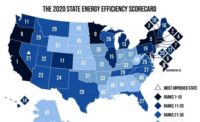As new rules are introduced, a learning curve is sometimes associated with them, and creative solutions are required to avoid problems down the road. One such learning curve became apparent in Rochester, N.Y., when LeChase was hired as the construction manager-at-risk for the construction of a new 75,000-square-foot math and science center at Nazareth College.
Construction on the LEED Registered project, with a goal of Silver certification, began in April 2011. The building was coming along smoothly until an obstacle became apparent with the concrete slabs on deck and grade. It started with a new NYSDEC regulation requiring flooring adhesives to be low in volatile organic compounds (VOC). While there wasn’t a problem with the new water-based adhesives specified for the project or the regulation itself, these factors compounded the issue. The new adhesives required the moisture level in the concrete to be significantly reduced prior to the flooring installation, and excessive moisture can be caused by the use of lightweight, high fly ash content concrete — like the concrete used in the math and science center. This combination meant the project was facing serious quality issues with the flooring; a failure to remove the moisture could result in the moisture dissolving the adhesive, bubbling the flooring and causing a flooring failure.
The flooring contractors, Messner Flooring and E.G. Sackett, made the project team aware of the need to remove the excess moisture from the floor. However, this presented a serious time and cost issue for the project. The project team met with Michael LaPoint, director of Construction and Renovation Services at Nazareth College, to go over the issue. Along with the project team, LaPoint wanted to find a solution that would minimize the impact on both the project schedule and project budget.
Messner Flooring and E. G. Sackett told LeChase that the only way to meet the manufacturing requirements was to seal the floors with epoxy sealant/primer, which would seal the moisture in the slab to prevent it from coming through to affect the adhesions. This option, LeChase was told, wouldn’t affect the project schedule, yet it would significantly impact the project budget with a cost in the neighborhood of $4 to $8 per square foot. In total, the option would add between $240,000 and $480,000 to the project budget in order to cover the more than 60,000 square feet of floor.
“It didn’t take long for us to realize that we had to jump on this issue,” says LaPoint, “It took a few phone calls, but people came up with alternate options just a few days before we had to make a decision.”
The three options to get rid of the residual moisture were:
- The team could wait for the floors to naturally dehumidify. This option had no impact on the project budget, however, the project schedule would suffer tremendously. Natural dehumidification could take up to 12 months, and the schedule just would not allow for that.
- A more timely solution would be to seal the floors with the expensive sealant, but that would put the project severely over budget.
- A third option was to run the permanent heating and ventilation system to draw out the moisture. This solution would potentially work on a renovation project, but since this was new construction, the HVAC system was not yet completed and would not be for several weeks. The project team would have to wait until the end of the project to employ this option, which would result in a schedule delay.
LeChase project engineer Joe Fazio knew that the project could not afford schedule delays, so the natural humidification and permanent HVAC options were out. Fazio also knew that Nazareth would want a lower cost solution than the special sealant. Faced with this dilemma, Fazio spoke with Don Grace, the LeChase project manager, and Jim Schillinger, the LeChase superintendent. Grace, Fazio and Schillinger examined alternative options, discussing possibilities with Steve Beck, LeChase’s chief sustainability officer. Beck put another solution on the table: LeChase could rent dehumidifiers to draw out the excess moisture. Beck and other LeChase project teams had used this option in the past when working with gymnasiums or other hardwood flooring.
This proved to be a win-win solution for the project as it would not drive up the project cost or significantly negatively impact the project schedule. By accelerating the dehumidification process with the rented dehumidifiers, the moisture would be drawn out and not compromise the floor adhesion. LeChase rented the dehumidifiers for a two-month period, which cost only $50,000 — a vast difference from the sealant solution.
Lessons Learned
The dehumidifiers ended up being a successful option for the Nazareth math and science center project. It worked for most of the areas, and LeChase was able
to reach 85 percent relative humidity or lower for the rubber and carpet areas. This solution did not prove successful for the epoxy or terrazzo areas as 75 percent humidity or lower is required. LeChase did have to purchase the special sealant for those limited areas.
Another inconvenience was the timing of the window installations. Windows were being installed at the same time the dehumidifiers were rented, which made the problem harder to solve. There were many gaps due to the window installations; the dehumidifiers would have been more effective if the window installations had not fallen behind.
LeChase was proactive with this math and science center project because the project team saw the problem before it was too late. The team was careful to understand concrete issues relative to the new floor adhesives. In all projects, it’s beneficial to be cognizant of all flooring issues and overall moisture management before work has even begun. To that end, understand how a building progresses with drying. Perform tests. Plan project schedules and allow time for either natural dehumidification or use of the permanent HVAC system structure — if that’s an option. If schedules won’t allow for natural dehumidification, remember the rental option as another time- and money-saving solution. Trapping moisture could cause floor failure and even mold issues, which is a highly sensitive topic of concern for owners and is a hot button topic across the industry.
If you have questions and/or concerns, raise the flag early in the project; ideally before the start of actual work.
|
When you find yourself starting on a new project, remember to do the following right away: |
|






